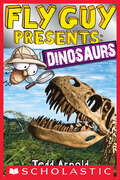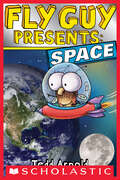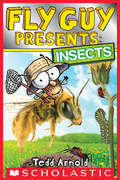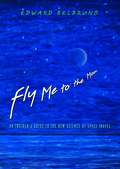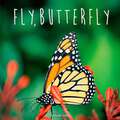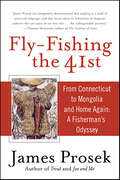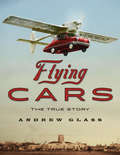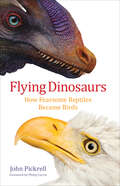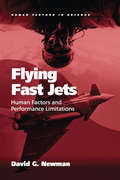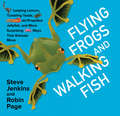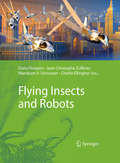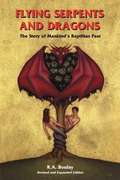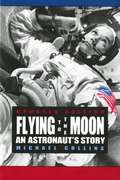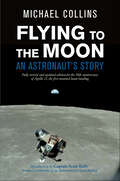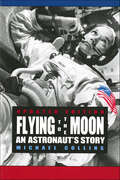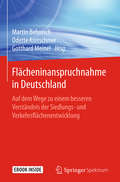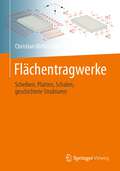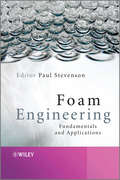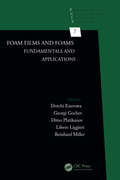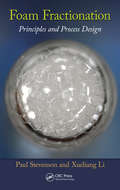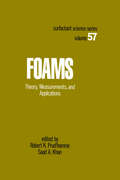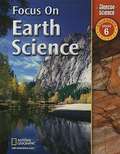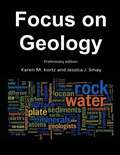- Table View
- List View
Fly Guy Presents: Dinosaurios/ Dinosaurs (Scholastic Reader, Level 2)
by Tedd ArnoldLearn all about dinosaurs with Fly Guy and Buzz!Fly Guy and Buzz are ready for their next field trip! And in FLY GUY PRESENTS: DINOSAURS they visit a natural history museum to learn all about dinosaurs. With straightforward text, humorous asides, and kid-friendly full-bleed photographs throughout, young readers will learn lots of fun facts about these prehistoric creatures. Award-winning author/illustrator Tedd Arnold really brings nonfiction to life in this fun nonfiction reader!
Fly Guy Presents: Four Books In One (Scholastic Reader, Level 2)
by Tedd ArnoldFly Guy and Buzz are back with another great nonfiction book!Award-winning author/illustrator Tedd Arnold brings nonfiction to life in this engaging nonfiction reader! During a visit to a space museum, Fly Guy and Buzz learn all about planets, space crafts, space suits, and even dirty snowballs (i.e. comets!)! With straightforward fun facts, humorous illustrations of Fly Guy and Buzz, and vivid photographs throughout, this book is sure to be a hit with budding astronauts everywhere!*HOLOGRAPHIC FOIL ON THE COVER!*
Fly Guy Presents: Insects (Scholastic Reader, Level 2 #2)
by Tedd ArnoldLearn all about insects with Fly Guy and Buzz!Fly Guy and Buzz are ready for their next field trip! And in FLY GUY PRESENTS: INSECTS they go outside to learn all about other insects like Fly Guy! With straightforward text, humorous asides, and kid-friendly full-bleed photographs throughout, young readers will learn lots of fun facts about all sorts of bugs. Award-winning author/illustrator Tedd Arnold really brings nonfiction to life!
Fly Me to the Moon: An Insider's Guide to the New Science of Space Travel
by Edward BelbrunoWhen a leaf falls on a windy day, it drifts and tumbles, tossed every which way on the breeze. This is chaos in action. In Fly Me to the Moon, Edward Belbruno shows how to harness the same principle for low-fuel space travel--or, as he puts it, "surfing the gravitational field." Belbruno devised one of the most exciting concepts now being used in space flight, that of swinging through the cosmos on the subtle fluctuations of the planets' gravitational pulls. His idea was met with skepticism until 1991, when he used it to get a stray Japanese satellite back on course to the Moon. The successful rescue represented the first application of chaos to space travel and ushered in an emerging new field. Part memoir, part scientific adventure story, Fly Me to the Moon gives a gripping insider's account of that mission and of Belbruno's personal struggles with the science establishment. Along the way, Belbruno introduces readers to recent breathtaking advances in American space exploration. He discusses ways to capture and redirect asteroids; presents new research on the origin of the Moon; weighs in on discoveries like 2003 UB313 (now named Eris), a dwarf planet detected in the far outer reaches of our solar system--and much more. Grounded in Belbruno's own rigorous theoretical research but written for a general audience, Fly Me to the Moon is for anybody who has ever felt moved by the spirit of discovery.
Fly, Butterfly (Penguin Core Concepts)
by Bonnie BaderExposing children to a diverse range of literary and informational texts, the Core Concepts program helps develop important literacy and cognitive skills necessary to meet many of the Common Core State Standards. Did you know that every year hundreds of thousands of monarch butterflies migrate 2,500 miles to Mexico for the winter? It takes four generations of butterflies to make the trip, and only the fourth generation lives longer than three weeks. Follow a beautiful butterfly as she makes her journey down to Mexico!Fly, Butterfly covers the concepts Animals and Seasons.
Fly-Fishing the 41st: From Connecticut to Mongolia and Home Again—A Fisherman's Oddesy
by James Prosek“James Prosek has eloquently demonstrated that angling is a kind of universal language. . . . he has taken us on an unforgettable journey.” — Thomas McGuane, author of The Cadence of Grass and The Longest Silence: A Life in FishingThe New York Times has called James Prosek "the Audubon of the fishing world," and in Fly-Fishing the 41st, he uses his talent for descriptive writing to illuminate an astonishing adventure. Beginning in his hometown of Easton, Connecticut, Prosek circumnavigates the globe along the 41st parallel, traveling through Spain, Greece, Turkey, Armenia, Kyrgyzstan, China, and Japan. Along the way he shares some of the best fishing in the world with a host of wonderfully eccentric and memorable characters.
Flying Cars: The True Story
by Andrew GlassStories of inventors who have aimed for the sky: &“Start your engines and get ready to take off for an amazing read&” (Kirkus Reviews, starred review). Humans have always wanted to fly—and as soon as there were planes and cars, many people saw a combination of the two as the next step for personal transportation. Visionary engineers and inventors did their best to make the flying car a reality, not just an elusive dream. This book is a breezy account of hybrid vehicles and their creators, and of the intense drive that kept bringing inventors back to the drawing board despite repeated failures and the dictates of common sense. Illustrated with archival photos, this entertaining survey tells the stories of dreamers from Robert Fulton to Henry Ford to Buckminster Fuller, taking readers as far back as Icarus and forward into the present day—with a look toward the possibilities of the future as well. &“Readers learn about many intriguing airplane-car hybrids, such as the Airphibian, invented by Robert Fulton, who flew his vehicle at 110 miles per hour, landed it, single-handedly converted it into a car in under five minutes, then &‘drove the convertible proudly into Manhattan at a breezy 55 miles per hour.&’ These stories of invention are undeniably appealing. . . . Fascinating.&” —School Library Journal Includes illustrations, source notes, bibliography, and an index
Flying Dinosaurs: How Fearsome Reptiles Became Birds
by John PickrellThe discovery of stunning, feathered dinosaur fossils coming out of China since 2006 suggest that these creatures were much more bird-like than paleontologists previously imagined. Further evidence—bones, genetics, eggs, behavior, and more—has shown a seamless transition from fleet-footed carnivores to the ancestors of modern birds.Mixing colorful portraits with news on the latest fossil findings and interviews with leading paleontologists in the United States, China, Europe, and Australia, John Pickrell explains and details dinosaurs' development of flight. This special capacity introduced a whole new range of abilities for the animals and helped them survive a mass extinction, when thousands of other dinosaur species that once populated the Earth did not. Pickrell also turns his journalistic eye toward the stories behind the latest discoveries, investigating the role of the Chinese black market in trading fossils, the controversies among various dinosaur hunters, the interference of national governments intent on protecting scientific information, and the race to publish findings first that make this research such a dynamic area of science.
Flying Dinosaurs: How Fearsome Reptiles Became Birds
by John Pickrell&“It will be difficult for any reader to think about dinosaurs—or birds—in the same ways they had before.&”—Publishers Weekly The discovery of stunning, feathered dinosaur fossils coming out of China in the twentieth century suggests that these creatures were much more bird-like than paleontologists previously imagined. Further evidence—bones, genetics, eggs, behavior, and more—has shown a seamless transition from fleet-footed carnivores to the ancestors of modern birds. Mixing colorful portraits with news on the latest fossil findings and interviews with leading paleontologists in the United States, China, Europe, and Australia, John Pickrell explains and details dinosaurs&’ development of flight. This special capacity introduced a whole new range of abilities for the animals and helped them survive a mass extinction, when thousands of other dinosaur species that once populated Earth did not. Pickrell also turns his journalistic eye toward the stories behind the latest discoveries, investigating the role of the Chinese black market in trading fossils, the controversies among various dinosaur hunters, the interference of national governments intent on protecting scientific information, and the race to publish findings first that make this research such a dynamic area of science. &“Fascinating.&”
Flying Fast Jets: Human Factors and Performance Limitations (Human Factors in Defence)
by David G. NewmanThis book provides a detailed general overview of the human factors and performance limitations associated with flying fast jets, integrating all the latest available research literature on the demanding operational tasks faced by such pilots and aircrews. As such, it has a strong military focus, dealing with pilots of fighter aircraft, attack aircraft and lead-in fighter trainer aircraft that are traditionally only single or dual pilot operations. The book deals not only with the issue of G force, but discusses ejection and escape/survival, disorientation, high altitude physiology, pilot training and selection, helmet-mounted equipment, situational awareness, data fusion and multi-sensor integration, human machine interface issues and advanced cockpit design. It examines the human performance issues associated with the technological advances made in fast jets, such as increased manoeuvrability, increased use of the pilot’s head as a mounting platform for sensor and weapons systems, and the complexities involved in the human-machine interface within these aircraft.
Flying Frogs and Walking Fish: Leaping Lemurs, Tumbling Toads, Jet-Propelled Jellyfish, and More Surprising Ways That Animals Move
by Steve Jenkins Robin PageA red-lipped batfish waddles across the sea floor on its fins, searching for small sea creatures to eat. Other animals may fly or glide, or jet-propel themselves to get around. These creatures come equipped with legs, wings, or tentacles, and they often move from place to place in surprising ways. In the latest eye-catching escape into the kingdom of Animalia, Caldecott Honor-winning team Jenkins and Page show how animals roll, fly, walk, leap, climb, swim and even flip! This fascinating and fun illustrated nonfiction melds science, art, biology, and the environment together in a detailed and well-researched book about how animals move in our world today.
Flying Insects and Robots
by Dario Floreano Jean-Christophe Zufferey Mandyam V. Srinivasan Charlie EllingtonFlying insects are intelligent micromachines capable of exquisite maneuvers in unpredictable environments. Understanding these systems advances our knowledge of flight control, sensor suites, and unsteady aerodynamics, which is of crucial interest to engineers developing intelligent flying robots or micro air vehicles (MAVs). The insights we gain when synthesizing bioinspired systems can in turn benefit the fields of neurophysiology, ethology and zoology by providing real-life tests of the proposed models. This book was written by biologists and engineers leading the research in this crossdisciplinary field. It examines all aspects of the mechanics, technology and intelligence of insects and insectoids. After introductory-level overviews of flight control in insects, dedicated chapters focus on the development of autonomous flying systems using biological principles to sense their surroundings and autonomously navigate. A significant part of the book is dedicated to the mechanics and control of flapping wings both in insects and artificial systems. Finally hybrid locomotion, energy harvesting and manufacturing of small flying robots are covered. A particular feature of the book is the depth on realization topics such as control engineering, electronics, mechanics, optics, robotics and manufacturing. This book will be of interest to academic and industrial researchers engaged with theory and engineering in the domains of aerial robotics, artificial intelligence, and entomology.
Flying Serpents and Dragons: The Story of Man's Reptilian Past
by R. A. BoulayWorld-wide legends refer to giant flying lizards and dragons which came to this planet and founded the ancient civilizations of Mesopotamia, Egypt, India and China. Who were these reptilian creatures? This book provides the answers to many of the riddles of history.
Flying to the Moon: An Astronaut's Story
by Michael CollinsIn this entrancing account, space traveler Michael Collins recalls his early days as an Air Force test pilot, his astronaut training at NASA, and his unparalleled experiences in orbit, including the Apollo 11 mission, the first manned lunar landing. The final chapter to his autobiography, revised and updated for this edition, is an exciting and convincing argument in favor of mankind's continued exploration of our universe.
Flying to the Moon: An Astronaut's Story
by Michael CollinsBased on the adult bestseller Carrying the FireIn time for the 50th anniversary of man's first landing on the moon, this re-release of Michael Collins's autobiography is a bold, sparkling testament to exploration and perseverance. In this captivating account, space traveler Collins recalls his early days as an Air Force test pilot, his training at NASA, and his unparalleled experiences in orbit, including the Apollo 11 mission, the first manned lunar landing. The final chapter to this autobiography is an exciting and convincing argument in favor of mankind's continued exploration of our universe. Originally published in 1976 and updated for this new edition, including an introduction from astronaut Scott Kelly, Collins's voice and message are sure to resonate with a new generation of readers.
Flying to the Moon: An Astronaut's Story
by Michael CollinsIn this entrancing account, space traveler Michael Collins recalls his early days as an Air Force test pilot, his astronaut training at NASA, and his unparalleled experiences in orbit, including the Apollo 11 mission, the first manned lunar landing. The final chapter to his autobiography, revised and updated for this edition of Flying to the Moon, is an exciting and convincing argument in favor of mankind's continued exploration of our universe. "Several astronauts have written about their experiences, but none so well as Michael Collins...This is just the book to give the child whose parents made Yeager and The Right Stuff best sellers."-The Washington Post Book World
Flächeninanspruchnahme in Deutschland: Auf dem Wege zu einem besseren Verständnis der Siedlungs- und Verkehrsflächenentwicklung
by Martin Behnisch Gotthard Meinel Odette KretschmerDieses Buch behandelt konzeptionelle und methodische Grundlagen zur Beschreibung und Erklärung der Flächennutzung und Flächenentwicklung. Ausgewählte Autorinnen und Autoren aus verschiedensten Forschungs- und Planungsinstitutionen stellen eine breite Vielfalt an aktuellen Forschungsansätzen zur Umwidmung von Freiflächen in Siedlungs- und Verkehrsflächen (Flächeninanspruchnahme) in Deutschland vor.In den einzelnen Kapiteln wird auf wichtige Fragen eingegangen: Wie messen und erklären wir Zustand und Struktur der Flächennutzung? Welche Instrumente können langfristig eine nachhaltige Flächenentwicklung unterstützen? Welche Herausforderungen bestehen für das Flächenmanagement im ländlichen Raum? Welche Einflussgrößen prägen die Siedlungsstruktur und Siedlungsentwicklung in Deutschland? Das Buch richtet sich an alle, die sich für den schonenden Umgang mit der begrenzten Ressource Boden, die räumliche Struktur und Entwicklung der Flächeninanspruchnahme, das komplexe Ursachenbündel der Siedlungs- und Verkehrsflächenentwicklung und die Instrumente einer nachhaltigen und klimagerechten Flächennutzungsentwicklung interessieren.
Flächentragwerke: Scheiben, Platten, Schalen, geschichtete Strukturen
by Christian MittelstedtDieses Buch bietet eine umfassende Darstellung der Statik der Flächentragwerke und ist in fünf Abschnitte unterteilt. Nachdem im ersten Abschnitt die Grundlagen der Elastizitätstheorie und der Energiemethoden der Elastostatik kurz eingeführt wurden, widmet sich der zweite Abschnitt der Statik der Scheibentragwerke. Neben isotropen Scheiben in kartesischen und polaren Koordinaten werden außerdem Näherungsverfahren sowie anisotrope Scheiben behandelt. Der nachfolgende dritte Abschnitt behandelt Plattenstrukturen, wobei auch hier Platten in kartesischen und polaren Koordinaten behandelt werden und zudem Näherungsverfahren sowie Plattentheorien höherer Ordnung besprochen werden. Weitere Kapitel dieses Abschnitts behandeln das Plattenbeulen sowie die geometrisch nichtlineare Analyse. Der vierte Abschnitt dieses Buchs ist der Statik geschichteter Flächentragwerke gewidmet. Hierbei werden sowohl die Klassische Laminattheorie als auch Laminattheorien höherer Ordnung diskutiert, und als ein Spezialfall wird die sog. Sandwichbauweise angesprochen. Der fünfte und letzte Abschnitt dieses Buchs ist den Schalen, also gekrümmten Flächentragwerken gewidmet, wobei hier der gängigen Einteilung in die Membrantheorie einerseits und der Biegetheorie andererseits gefolgt wird.Dieses Buch richtet sich an Studierende an Fachhochschulen und Universitäten, aber auch an Ingenieurinnen und Ingenieure in der Praxis sowie an Forscherinnen und Forscher der Ingenieurwissenschaften.
Foam Engineering
by Paul StevensonContaining contributions from leading academic and industrial researchers, this book provides a much needed update of foam science research. The first section of the book presents an accessible summary of the theory and fundamentals of foams. This includes chapters on morphology, drainage, Ostwald ripening, coalescence, rheology, and pneumatic foams.The second section demonstrates how this theory is used in a wide range of industrial applications, including foam fractionation, froth flotation and foam mitigation. It includes chapters on suprafroths, flotation of oil sands, foams in enhancing petroleum recovery, Gas-liquid Mass Transfer in foam, foams in glass manufacturing, fire-fighting foam technology and consumer product foams.Key features:Foam fractionation is an exciting and emerging technology, starting to gain significant attentionDiscusses a vital topic for many industries, especially mineral processing, petroleum engineering, bioengineering, consumer products and food sectorLinks foam science theory to industrial applications, making it accessible to an engineering science audienceSummarizes the latest developments in this rapidly progressing area of researchContains contributions from leading international researchers from academia and industry
Foam Films and Foams: Fundamentals and Applications (Progress in Colloid and Interface Science)
by Dotchi Exerowa, Georgi Gochev, Dimo Platikanov, Libero Liggieri and Reinhard MillerThis book describes in detail the scientific philosophy of the formation and stabilization-destabilization of foams. It presents all hierarchical steps of a foam, starting from the properties of adsorption layers formed by foaming agents, discussing the properties of foam films as the building blocks of a foam, and then describing details of real foams, including many fields of application. The information presented in the book is useful to people working on the formulation of foams or attempting to avoid or destruct foams in unwanted situations.
Foam Fractionation: Principles and Process Design
by Xueliang Li Paul StevensonFoam fractionation is a separation process in which proteins and other amphipathic species adsorb to the surface of bubbles. The bubbles are then removed from the solution in the form of foam at the top of a column. Due to its cost-effectiveness, foam fractionation has the potential for rapid commercial growth, especially in biotechnology.To assist
Foams: Theory: Measurements: Applications
by RobertK. Prud'hommeThis volume discusses the physics and physical processes of foam and foaming. It delineates various measurement techniques for characterizing foams and foam properties as well as the chemistry and application of foams. The use of foams in the textile industry, personal care products, enhanced oil recovery, firefighting and mineral floatation are highlighted, and the connection between the microstructure and physical properties of foam are detailed. Coverage includes nonaqueous foams and silicone antifoams, and more.
Focus On Earth Science
by James Sammons Mary Beth Abel Hughes Patsy Eldridge Lynda PennellNIMAC-sourced textbook
Focus On Earth Science (California)
by Douglas Fisher Dinah Zike National Geographic Donna L. Ross Elizabeth A. Nagy-Shadman Jan Vermilye Joseph J. Kerski Juli Berwald Julie Meyer Sheets Nancy Trautmann Sergio A. GuazzottiNIMAC-sourced textbook
Focus On Geology Preliminary Edition
by Karen Kortz Jessica SmayThis Physical Geology textbook uses cutting edge research to guide the creation of carefully structured pages that cover topics commonly taught in introductory physical geology courses. The book is focused around images and emphasizes the key concepts Research (e.g. Mayer, 2003) indicates that students learn more deeply: - when extraneous material is excluded rather than included, - from words and pictures than from words alone, - when printed words are placed near rather than far from corresponding pictures, and - when words are presented in conversational rather than formal style. Most traditional geoscience textbooks do not address this research. Although geoscience textbooks are image-rich, the text is often separate from figures, generally with a note in the text referring the student to look at the image. Research indicates that many students just glance at the images or ignore them altogether, resulting in a less productive learning experience than intended by the authors. Also, most textbooks, even "essentials" versions, tend to have more information than an introductory student can learn in a semester, and the students, therefore, have a difficult time distilling the key concepts from the details. Images play an integral role in the textbook. There are no long blocks of text to read, but, instead, most information is presented incorporated in or around figures. Students therefore examine the images, integrating text and figures, which results in a deeper learning experience. Concepts are represented in multiple ways (photographs, written descriptions, detailed drawings, sketches, graphs, analogies, etc.) to maximize student learning. Because research indicates that students have a difficult time pulling out the key points from images, many of the images in this book are simple, without too many realistic-but-distracting details. Many of the photographs are accompanied by a simplified sketch of the same area illustrating the important geological features shown. The process of comparing two images presenting the same information in different ways (e.g. a photograph and a sketch) directs students to observe the important features and requires students to integrate those two images, strengthening their learning. Simple language is used when writing, and non-essential vocabulary words are omitted, so students will not focus on memorizing definitions without understanding the concepts. The book has a more conversational style than many current textbooks. This textbook presents the key concepts in geoscience without additional distracting details. As a result, this book is shorter than other books currently on the market. The concise nature of the book encourages students to read it. Because it emphasizes the key concepts, students have a better understanding of the fundamentals and will come to class more prepared. Therefore, instructors will be able to cover additional information in class, because the fundamentals are already understood by the students. The themes in the book are plate tectonics, water cycle, rock cycle and how geology and people affect each other. These are concepts that are key in understanding geoology and learning why it is relevant in today's society. These three themes are emphasized, and individual topics are related back to the overarching themes.
